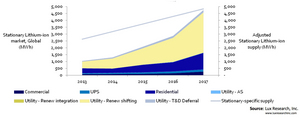BOSTON, MA--(Marketwired - Oct 22, 2013) - Led by Lithium-ion, emerging battery technologies used in the backup and UPS markets will grow six-fold from $143 million this year to $896 million in 2020, as storage developers shift focus in the face of tumult and uncertainty in the emerging grid storage market, according to Lux Research.
Li-ion batteries will account for a bulk of this market, reaching $553 million in 2020, and additionally restoring demand-supply balance in the Li-ion market. The medical, commercial and datacenter operators are the major users of the conventional backup and UPS markets, which have a global installation base of 800 GW, or 15% of global peak consumption.
"Energy storage developers continue to pump blood, sweat, tears, and cash into emerging markets for energy storage. However, the wisest developers have recently focused efforts on the mature backup and UPS markets for stable revenues," said Steven Minnihan, Lux Research Senior Analyst and the lead author of the report titled, "Backup and UPS: Stable Growth in the Unstable Stationary Storage Markets."
The Li-ion chemistry offers enhanced life and power density over incumbent lead acid systems, justifying higher capital expenditure. This market growth carries an additional payoff in bringing the global demand for stationary Li-ion systems in line with forecasted supply, ending years of glut, he added.
Lux Research analysts studied the broader impact of the battery technologies on the global stationary storage market. Among their conclusions:
- Li-ion offers modest cuts in TCO. As lithium-ion developers struggle to find large-volume customers, the UPS and backup markets offer a chance for modest, steady growth. The sector will add 12.5% to global demand for stationary lithium-ion systems. The Li-ion developers, in return, offer a modest 4% to 11% reduction in total cost of ownership over competing lead acid.
- Sodium nickel chloride battery market will grow. The sodium nickel chloride battery, which offers significant cost benefits for high-use applications on account of its low capital cost and significant energy capacity, will grow to $116 million in the backup market in 2020. On the other hand, power-dense technologies including flywheels and ultracapacitors will not find a home in UPS because of their low energy density and prohibitive cost.
- End to Li-ion glut in sight. Of the 14 GWh of forecasted Li-ion production in 2017, only 5 GWh will target stationary applications, thanks to demand from the consumer and mobile sectors. This will help strike a delicate balance between global supply and demand, ending years of oversupply and eroding margins.
The report, titled "Backup and UPS: Stable Growth in the Unstable Stationary Storage Markets," is part of the Lux Research Grid Storage Intelligence service.
About Lux Research
Lux Research provides strategic advice and ongoing intelligence for emerging technologies. Leaders in business, finance and government rely on us to help them make informed strategic decisions. Through our unique research approach focused on primary research and our extensive global network, we deliver insight, connections and competitive advantage to our clients. Visit www.luxresearchinc.com for more information.
Contact Information:
Contact:
Carole Jacques
Lux Research, Inc.
617-502-5314
carole.jacques@luxresearchinc.com
